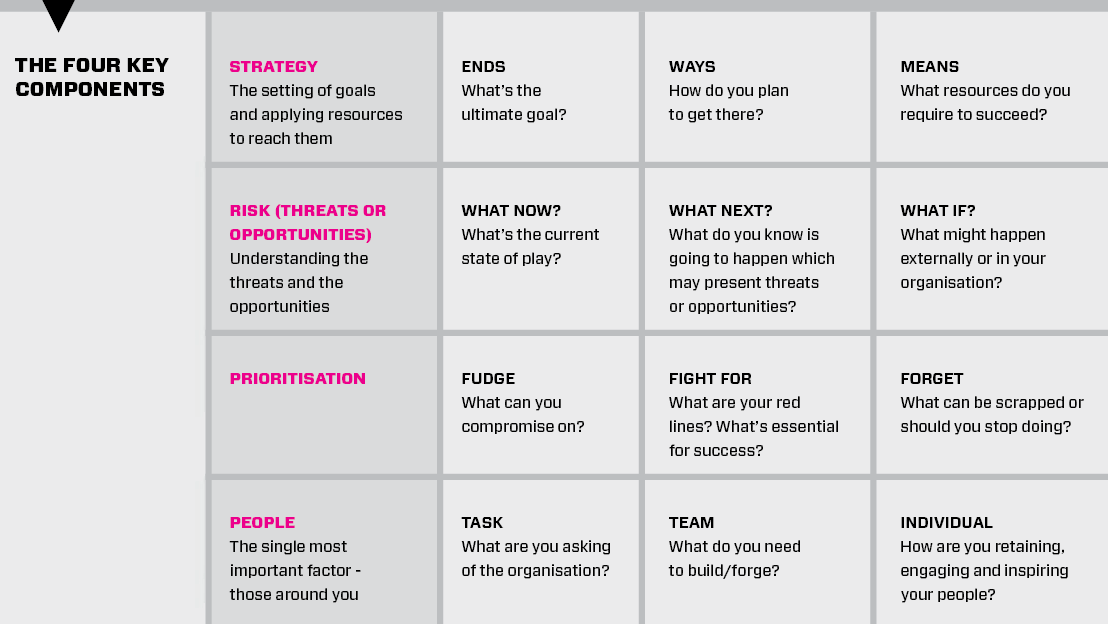The universal language of the boardroom pays dividends to those who can decode it, so here's a crash course
The purpose of the Whitehall and Industry Group is to encourage and facilitate better cooperation, understanding and learning across the public, private and not-for-profit sectors. There is a misconception that these three entities speak a different language. They don’t. Let me explain.
There are only four themes any organisation talks about, and there are only three fundamental topics within each of those. The challenge is merely identifying what is being discussed and understanding, consequently, what is not being discussed (often a more interesting discovery and a great way of impressing colleagues in meetings). Let me talk you through it and you can try it for yourself.
The four themes, or pillars, are: strategy, risk, priorities and people; taking each in turn.
Strategy is the often quoted “ends”, “ways” and “means”. Or, to put it another way, the application of resource in such a way as to achieve a desired outcome or goal. So, for instance, a conversation about a fundamental change in aims immediately begs questions over the required means and modifications to the plan to deliver the new outcome.
Risk considers the questions “what now?”, “what next?” and “what if?” Risk is both the threat posed or opportunity presented by possible events. We are all used to treating risk through mitigations and the like, but the time element is often ignored. So too is the strength of likelihood set against the analysis (not just data) available. Therefore a conversation about a “what if?” possibility that crowds out a “what next?” analysis is obviously worthy of a question. For instance, perhaps a debate about setting aside “means” to mitigate a possible business threat in three years’ time would seem out of place if the prospect of rising interest rates were not being discussed.
Priorities can also be viewed as labelling issues “fudge”, “fight for” or “forget”. Where can we compromise? Where are the red lines? And what can we stop doing? Often a difficult decision but ultimately nearly always necessary to square the “ends, ways and means” circle.
People covers “task”, “team” and “individual”, to borrow John Adair’s timeless Venn diagram of action centred leadership. It’s about the nature of the task, the forging of the team, and the individual’s requirements. Often this centres on the expertise required, but also has everything to do with leadership and development. This theme has a close relationship with “means”, “what next?”, and “ways” as well as – often and sadly – “fudge”.
So there is the common ground and vocabulary for one organisation to understand and communicate with another. It allows us to deal with even the most bewildering corporate or departmental verbiage such as: “The ‘forward first’ strategy will seek to capitalise on the inherent strengths of the organisation, while allowing the sort of agility we need to react to the future environment, it will generate the capacity required to concentrate on the essential elements of our unique outputs as well as maintain activity essential to our purpose.”
Faced with such statements, we can unpick the essential elements of changed ways (if there are no more “means” then what is being “fudged” or “forgotten” – or have the “ends” been changed too?). Other useful areas include a sense of doubling down on “fight for” elements as well as a clear signal about which elements will need to be “forgotten” and implications for “teams” to deliver agility.
Next time you are in a meeting, try playing boardroom bingo. Draw a table with our four themes down one side and the three related topics in the rows next to each. Listen hard and circle which combinations are being talked about.

What will leap out at you is the areas not being discussed. In no time at all, you can impress your colleagues and annoy the chair with questions like, “do we have the additional means to form the teams necessary for this, if we plan no compromise around our approach to delivery?”.
Alternatively, come to a WIG event and try out your new language skills with another sector. You’ll be fluent in no time!
Whitehall and Industry Group is an independent non-lobbying charity that looks to boost learning and collaboration between industry, government and the not-for-profit sector